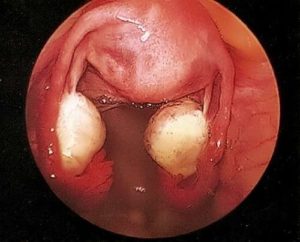
Diagnosed with Cancer? Your two greatest challenges are understanding cancer and understanding possible side effects from chemo and radiation. Knowledge is Power!
Learn about conventional, complementary, and integrative therapies.
Dealing with treatment side effects? Learn about evidence-based therapies to alleviate your symptoms.
Click the orange button to the right to learn more.
- You are here:
- Home »
- Blog »
- non-conventional therapies »
- Relapsed Ovarian Cancer- Alternative?
Relapsed Ovarian Cancer- Alternative?
Hello David; My wife has ovarian cancer. After a series of conventional chemotherapy treatments, we are considering antineoplaston therapy at the Burzynski Research Institute (BRI).
A little backgroud. My wife is 52 years old and in good health otherwise. She has had a successful operation to remove her ovaries. Her CA125 started in the 3,000 range, after the first round of Carboplatin/Taxol got down to 41. Then popped up, so we went to a new chemo regimen, Gemzar/Avastin.
Her CA125 dropped to 300 then went up. Then we were on Taxotere/Avastin for last couple of months, her CA125 dropped, to 3,000 but CT Scan didn’t show progress.
The recommendation was to go to a new drug. I have to say that my wife is getting fatigued by all the chemotherapy.
Now we have an appointment qt Burzynski Clinic this Tuesday. Do you recommend that?
Hi Sam,
- carboplatin/taxol-partial remission, relapse
- gemzar/avastin- partial remission, relapse
- taxotere/avastin- possible remission, possibly unresponsive
- Though my cancer, multiple myeloma, is very different from ovarian cancer, to some degree I am a “proof of concept.” Because I am only one example, I am linking case results below as well as a Pubmed study.
- Though I don’t know if ANP is non-toxic, technically speaking, I can say that ANP therapy is a cakewalk compared to my conventional therapies.
- I would not recommend ANP for the newly diagnosed ovarian cancer patient. I believe in your case Sal, the risk/reward equation has changed from that of the newly diagnosed ovarian cancer patient.
- Last but not least, its important to emphasize that your health insurance will probably NOT cover ANP therapy.
- I will add text info for ANP and the top 20 cancers below.
- Cancer Survivor
- Cancer Coach
- Director PeopleBeatingCancer
Recommended Reading:
- Intravenous Vitamin C Synergizes Chemo for Ovarian Cancer
- 6 Ways You Can Prepare for Cancer Surgery – Both Mentally and Physically
- Jan Pederson- Ovarian Cancer Treatment at Cancer Treatment Centers of America
Personalized cancer treatment for ovarian cancer.
|
Diagnosis
|
No. of patients
|
OR (%)
|
SD (%)
|
PD (%)
|
|
Non-Hodgkin’s Lymphoma
|
131
|
64
|
26
|
10
|
|
Breast Cancer
|
433
|
62
|
23
|
15
|
|
Carcinoma of unknown primary
|
42
|
57
|
36
|
7
|
|
Prostate Cancer
|
322
|
53
|
38
|
9
|
|
Ovarian Cancer
|
99
|
51
|
29
|
20
|
|
Head and Neck Cancer
|
87
|
51
|
29
|
20
|
|
Colon Cancer
|
229
|
51
|
28
|
21
|
|
Hodgkin’s Disease
|
16
|
50
|
38
|
12
|
|
Kidney Cancer
|
41
|
49
|
34
|
17
|
|
Malignant melanoma
|
63
|
49
|
21
|
30
|
|
Lung Cancer
|
179
|
46
|
33
|
21
|
|
Urinary Bladder and Urothelial Cancer
|
39
|
45
|
32
|
23
|
|
Esophageal and Stomach Cancer
|
55
|
44
|
29
|
27
|
|
Liver Cancer
|
20
|
40
|
25
|
35
|
|
Uterine, Cervix, Vulvar, Endometrium
|
51
|
39
|
31
|
30
|
|
Brain Tumor
|
189
|
37
|
39
|
24
|
|
Multiple Myeloma
|
21
|
36
|
43
|
|
|
Biliary Tract Tumor
|
20
|
30
|
40
|
30
|
|
Pancreatic Cancer
|
55
|
24
|
51
|
25
|
|
Mesothelioma
|
17
|
24
|
41
|
35
|


